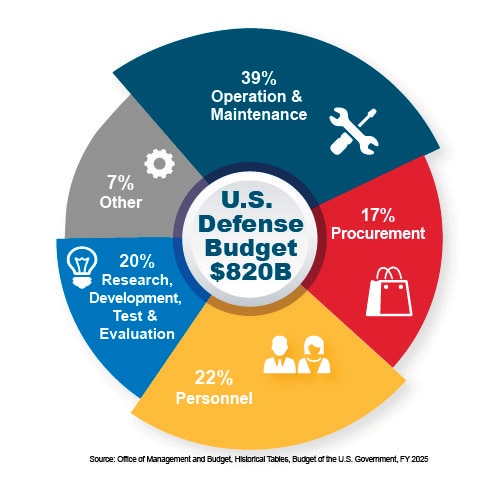Small Business Office demystifies the Air Force budget process
Small businesses with low overhead, agile processes, and innovative ideas are key to the Department of Defense's future success.
However, while small business owners may be experts in their field, many still struggle to fully understand the funding behind the acquisition process.
The Air Force Materiel Command Small Business Office hosted a presentation on "Decoding the Air Force Budget Process," at the Wright Brothers Institute in Dayton, Ohio, July 12, to demystify the planning and budget.
"This was one of our regularly scheduled 'colliders,'" said Jeff Mellott, Small Business Programs Director, AFMC. "Colliders are free and open small business events to identify opportunities, build relationships, and share topics of interest and supporting resources."
Nearly 90 individuals attended the collider in person or virtually via Zoom. Though geared to small businesses, the information shared at the event was valuable to anyone seeking to understand the Air Force budgeting process.
As with many government processes, the first challenge is learning the myriad terms and acronyms used.
"The Planning, Programming, Budgeting and Execution System, better known as the PPBE, consists of four distinct processes that happen simultaneously and consecutively," said Kristen O'Sullivan, Chief Strategic Plans and Programs, AFMC Headquarters, and keynote speaker for the event.
The Department of the Air Force annual PPBE process establishes the framework for decision-making on current and future programs. In addition, it reexamines and analyzes prior decisions from the viewpoint of the current environment (for example, current threats, technological, and resource constraints and opportunities). The ultimate objective is to ensure the service can provide the best mix of forces, equipment, and support attainable within fiscal constraints.
The first step is planning. This encompasses an in-depth review of the evolution in military capabilities and changes in policy over a long period of time and results in a strategy. Plans in progress now will affect the budget for 2029-2030 and fifty years beyond.
Next is the programming process, which culminates in "the POM" (Program Objective Memorandum or budget). This step is dependent upon a baseline, programing guidance, and fiscal parameters identifying how much money may be requested.
During the "POM build," AFMC will add and subtract from the baseline to prioritize program needs while staying within the assigned fiscal guidance.
The final step is the submission of the AFMC POM to the Air Force where it then competes for limited resources with the POMs submitted by the other Air Force major commands. The Air Force evaluates and prioritizes funding needs to formulate a consolidated Air Force-level POM covering the five-year Future Years Defense Program, reflecting a balanced allocation of resources given mission requirements and fiscal constraints.
The process sounds simple, but the competition for funds and the time it takes for justification and authorization are limiting. Most funds go towards personnel and infrastructure, so what is left is allocated to mission priorities and essential research and development and technology, the areas most familiar to small enterprises.
"The requirements we receive typically exceed what the government will actually be able to fund," said O'Sullivan. "So, our job is to 'rack and stack' the requirements, much like paying the bills and then balancing a checkbook."
Small businesses can receive assistance from the AFMC Small Business program office in understanding the acquisition process, registering their company and exploring opportunities.
The Small Business Office is the initial entryway to government contracting for companies entering the Air Force market.
"We can point businesses to the base or mission that best fits with their product or service," said Mellott. "Our job is to make connections and demystify the process for small businesses, allowing them to enable mission execution."
Individuals can access detailed information and training opportunities on the acquisition process at the Defense Acquisition University website: https://www.dau.edu/acquipedia-article/planning- programming-budgeting-execution-process-ppbe.
The AFMC Small Business office can be reached at afmc.sb.workflow@us.af.mil


